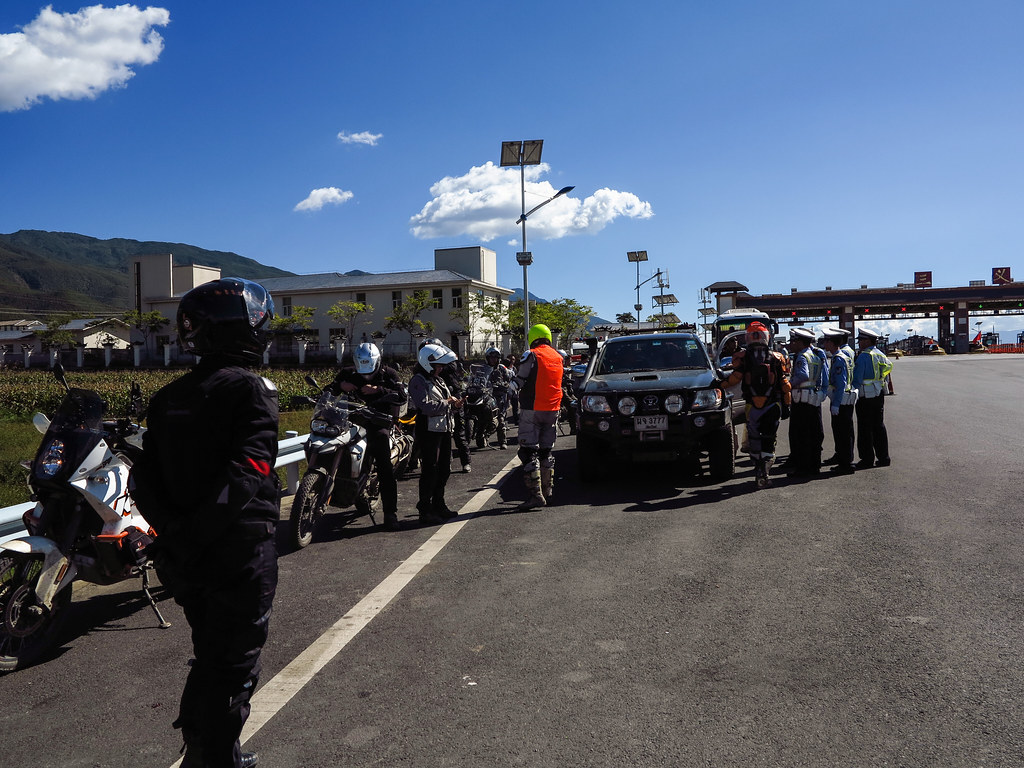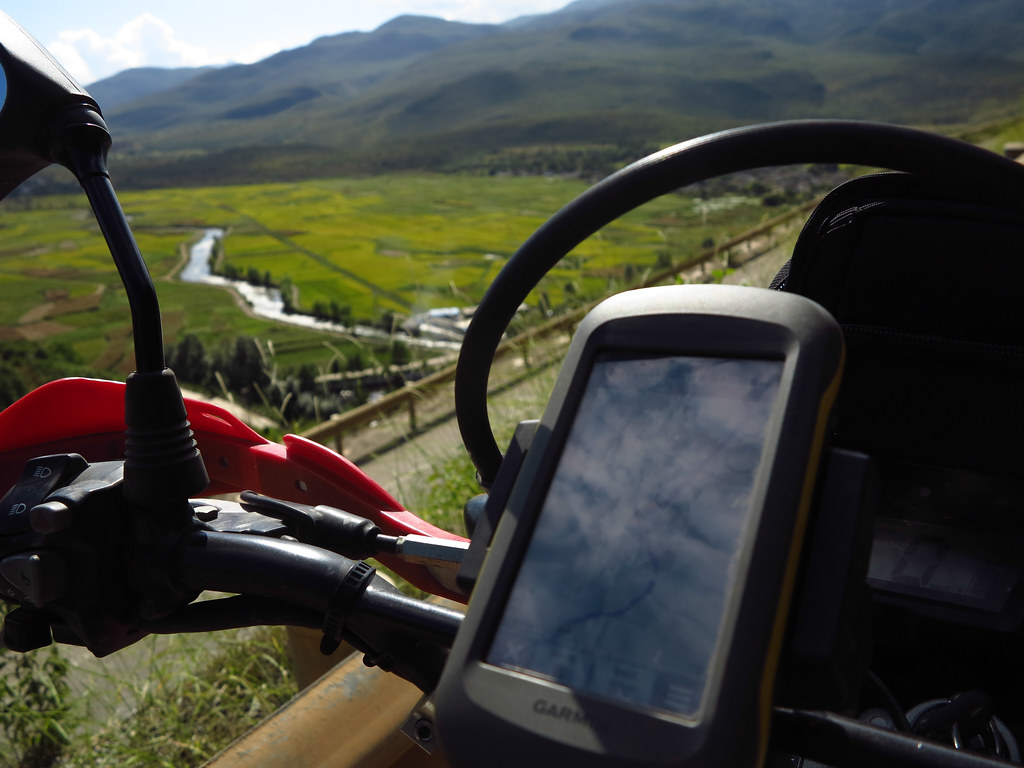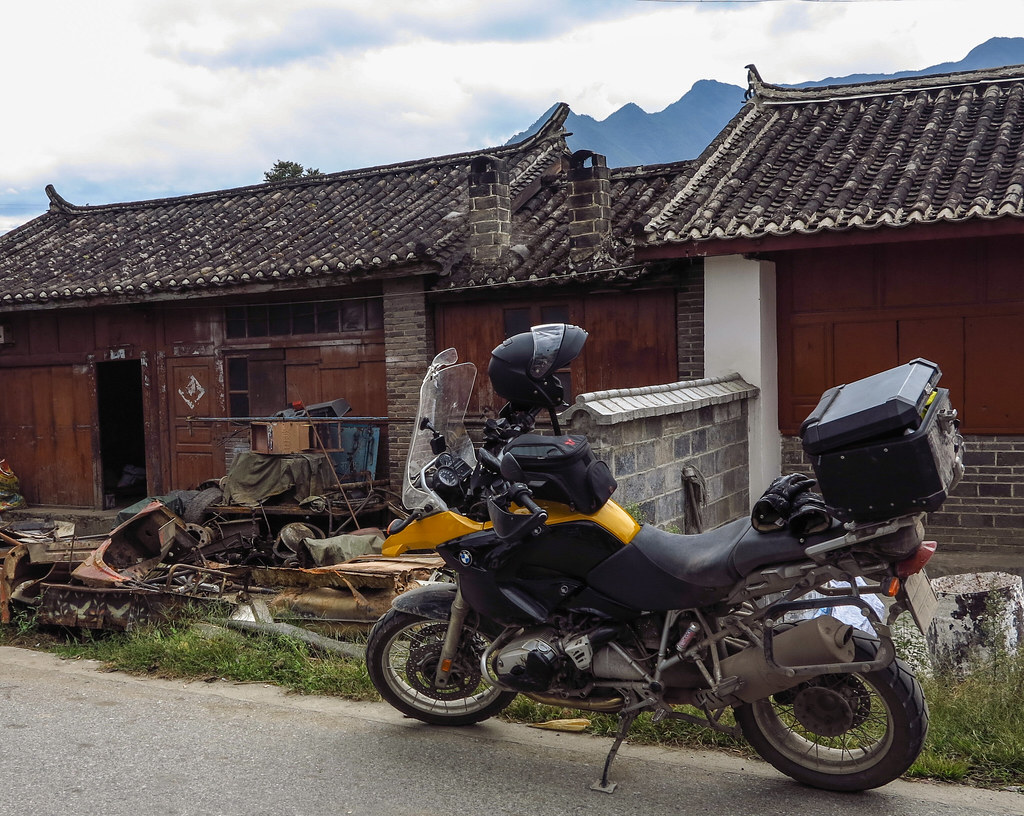A China motorcycle tour into Yunnan, China is one of the most spectacular places you can ride.
From Chiang Mai it’s only a 2 day ride and you’re in China.
Crossed out of Thailand no issues, then into Laos.
Into the Dokchampa GH in Luang Namtha, Laos.

A few BeerLao’s to celebrate our arrival in Laos

1st Beerlao in Laos, always tastes pretty special

Easy 60km ride east to Boten from Luang Namtha the next day, in the rain, everyone had rain gear
The new Laos customs and immigration offices at Boten, now open


Our wonderful Laos agent, Miss Lah, who did a fantastic job clearing us in to Laos at Houay Xai & out the next day at Boten, first class service.

Then the China entry song and dance starts, 2 months of paperwork, lets hope everything is in order



Mohan, China immigration, always a little confusing but all gets done in the end, never the same procedure!

Then the last little bit before you’re officially in China, motorcycle entry permit is checked and passport checked for Chinese visa and entry stamp

This time the Chinese policeman checked VIN and engine numbers on all of the bikes, never had this happen before


The mighty CRF, only a flat tire has been the problem so far

We thought we were all done, then the Mengla police decided they want to give us a road safety lesson in Chinese.

She was kind enough to pose for a picture with the bikes afterwards

Quite satisfying getting that all out of the way, time to check-in in Mengla

Confusion over we get on the right road and head for Jing Hong for a spot of lunch
Through the Jing Hong city traffic, to restaurant row
Beautiful temples in the city of Jing Hong

& of course Chinese tea, we’re now approaching the very southern end of the tea horse and caravan trail

We still have 178km to go to get to our destination for the evening & a planned stop at a tea plantation on the way north, so time to get cracking
Jing Hong



Kodak moment along the way, this apparently says hydro-electric station in Chinese

The locals were pretty amused by the foreigners

Hmong tribal scalf

Tea plantations were now all around us
Time looking ok, we stop at one of the tea plantations in Menghai, producers of the Pu’er tea
Pu-erh tea – Wikipedia, the free encyclopedia
Pu-erh or Pu’er tea is a variety of fermented dark tea produced in Yunnan province, China.[1][2][3] Fermentation is a tea production style in which the tea leaves undergo microbial fermentation and oxidation after they are dried and rolled.[4] This process is a Chinese specialty and produces tea known as Hei Cha (黑茶), commonly translated as dark, or black tea (this type of tea is completely different from what in West is known as “black tea”, which in China is called “red tea” 红茶). The most famous variety of this category of tea is Pu-erh from Yunnan Province, named after the trading post for dark tea during imperial China.[5]
Pu’er traditionally begins as a raw product known as “rough” Mao Cha (毛茶) and can be sold in this form or pressed into a number of shapes and sold as “raw” Sheng Cha (生茶). Both of these forms then undergo the complex process of gradual fermentation and maturation with time. The Wo Dui process (渥堆) developed in the mid-1970s by the Menghai [6] and Kunming Tea Factories [7] created a new type of pu-erh tea, whose legitimacy is disputed by some traditionalists. This process involves an accelerated fermentation into “ripe” Shou Cha (熟茶) which is then stored loose or pressed into various shapes. All types of pu-erh can be stored to mature before consumption, which is why it is commonly labelled with year and region of production.
We were told the tea was formed into bricks to keep the tea moist and in tact for travel and storage.


Safety is priority here at the tea plantation

They’ve actually tried to re-create what the tea horse trail would have looked like through the Himalaya’s to Lhasa, Tibet a few hundred years ago

& a decent map of where the tea horse trail lay (we’re currently at the bottom on the left on this map)

Horse handlers


This it what the horsemen used to wear, goat skin with horse hair for insulation

Saddles and tea cargo bound for Lhasa, Tibet, to be traded for silk, diamonds, spices etc…..

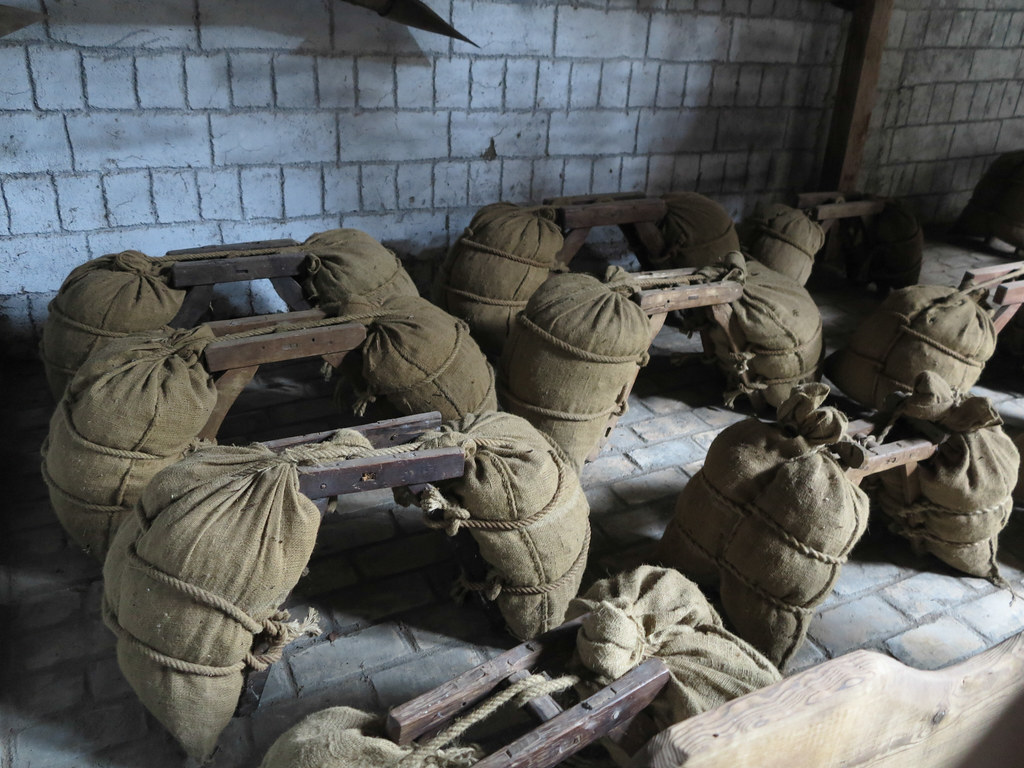
Cooking facilities how they would have been in one of the caravan inn’s along the trail

Blacksmith from times past on the tea horse trail

& Axel with a lovely Chinese girl that wanted her photo taken

All the tea is still picked by hand here



These one’s go clockwise


Back on the road and none of us are liking these sections in the corners, they look slippy

All we can see is tea

& also some of the biggest banana plantations i’ve ever seen

Really fun day & into the Hua Long Da Jui Dian Hotel for the night – 196 Yuan – USD$ 32 not to bad at all

Drizzly start up in the clouds leaving Lancang, Oddvar having a blast also on a Honda CRF 250 L
Today we’ll ride a couple of hundred KM’s NW & the first time we’ve seen the Mekong River in China (there is actually a confluence that will feed into the Mekong a few Km’s down)
Plenty of rain around to keep it pumping
Limestone, sedimentary rock, remnants from the ancient sea that used to engulf the region.
Dredging for sand from the river that will feed into the Mekong
200km north of the southern end of the tea horse trail and of course tea everywhere
You’ve got to love the local, modern, work horses, they do have some character
Drama free day apart from seeing a cute dog get killed. Into Lin Cang to the “L. Road Grand Hotel” & grand it is too.
We even got some VIP parking, normally they hate motorcycles in the classy hotels
Decent rooms, everyone is happy
Leaving Lin Cang the next morning, the big bikes caused quite a stir with the locals o their way to work, looks like this isn’t the route of many touring bikes through China
Mr. R keeping them amused
Then our first real good look at the Mekong River SW od Dali
& a beautiful suspension bridge too
A couple more, looked like a beautiful place to live
Weishan is famous for the Dali Bai ethnic Muslims & temples in the surrounding mountains
Weishan Yi and Hui Autonomous County – Wikipedia, the free encyclopedia
It’s the first time i’ve been here and quite interesting
Axel making new friends
We’ve been trying to eat the local delicacies from the autonomous regions that we’re traveling through. Dali prefecture, this is a local cold noodle salad that tastes very much like a Japanese dish.
It’s presented with different noodles and flavors & then mixed together at the table before consumption
A local dish, deep fried cheese made from cows milk. Not a very sour/ bite cheese but very tasty
& some locally brewed snake moonshine that we didn’t try
Like Oddvar, we stuck with the other Dali local beverage
Leaving the restaurant, we saw this and someone joked “they really are taking advantage of this tea horse and caravan thing arn’t they?”
Dali
Google Maps eat your heart out – chop sticks make great city maps where there’s grids
Some brake issues on a BMW F 800 gs so a late start, some time for a wander around Dali’s old town
Dali city
Dali City – Wikipedia, the free encyclopedia
Dali is the ancient capital of both the Bai kingdom Nanzhao, which flourished in the area during the 8th and 9th centuries, and the Kingdom of Dali, which reigned from 937–1253. Situated in a once significantly Muslim part of South China, Dali was also the center of the Panthay Rebellion against the reigning imperial Qing Dynasty from 1856–1863. It was severely damaged during an earthquake in 1925.[1]
Dali is also famous for the many types of marble it produces, which are used primarily in construction and for decorative objects. In fact, Dali is so famous for the stone that the name of marble in Chinese is literally “Dali Stone” (Chinese: 大理石; pinyin: dali shi).
Dali is now a major tourist destination, along with Lijiang, for both domestic and international tourists.Dali and Yunnan’s capital Kunming are only a 40-minute flight apart. Dali’s newly finished administrative district that houses the newly opened Dali International Convention Center is in Longshan District. The Dali government’s urban planning keeps its old and new districts separate, to encourage tourism. The “new city” is known as Xiaguan and is south of the old city. The old city was built during Ming Dynasty emperorHongwu‘s reign (1368–1398). Owing to the distance between them, the old city is still peaceful and quiet.
ClimateTempered by the low latitude and high elevation, Dali has a mild subtropical highland climate (Köppen Cwb), with short, mild, dry winters, and warm, rainy summers. Frost may occur in winter but the days still generally warm up to 15 °C (59 °F) or more. During summer, a majority of the days features some rainfall, and daytime temperatures rise to 24 °C (75 °F). A great majority of the year’s rainfall occurs from June to October.
Natural springs flow down from the mountain through Dali’s old town streets
No money no honey (for the photo)
Flower lady in a big hurry
Unusual
A few more pictures from around Dali’s old town
BMW F 800 all fixed with new brake pads which were available in Dali
Low pressure gone looks like it’s going to be a great riding day
Always some funny/ strange drama around in China. This lady parks and locks her Honda car in front of the exit barrier for 15 minutes because she’s arguing about the exit ticket, blocking 10 cars and 9 motorcycles from leaving the hotel
.
The rice changing color from bright green to yellow, we’re riding through at harvest time
Always interesting to see the different rice harvesting methods in SE Asia. Here, once the rice stalks are cut, they are taken to a large wicker basket and thrashed on the inside which makes the rice husks part from the stalk
Up into the Himalaya’s, cracking views
Then some real drama – Police checkpoint on the toll road headed into Lejiang, the police’s astonishment upon seeing us quite remarkable.
None of us spoke Chinese, they didn’t speak English and our ground handler was nowhere to be seen, quite an interesting situation, which highlighted why you shouldn’t venture into China without a tour, unless you’re ready for headaches.
My favorite shot so far, might get this framed
So they made us turn around and get off the toll road, first time i’ve ever had this happen in China. We should actually have thanked them, we had better views from the local road into Lijiang
Through the Lijiang city mayhem without too much trouble and managing to keep 9 bikes together through the traffic lights, we finally arrive at the Grand Lijiang Hotel
If you get an end room, you’ll have superb views of the Lijiang glacier
A fun after-dinner game in a Chinese restaurant – Chinese roulette
Get a toothpick, stick it to the edge of the spinning lazy susan
Everyone put say 10 Yuan out in front of them next to the lazy susan
Spin the lazy susan, the toothpick has to stop in front of your money (this can take 3 or 4 spins sets) & if it does you win the pot.
Oddvar with his winnings
The lazy susan makes for ingenious panoramic shots and group videos too
The security guard at the Grand Lijiang Hotel on his 3rd large Dali beer
Why is it an hour after Chinese food & you’re hungry again?
The edge of Lijiang’s old city by night
& a view hard to beat from your hotel room the next morning
Lijiang is a fantastic Chinese city to visit by motorcycle, it has everything. The old city is around 800 years old, for those tired of Chinese food by now, there’s a McDonalds, Pizza Hut & KFC all next to each other.
I’ve heard that Lijiang is the busiest tourist city for Chinese tourists in China. You’d think it would be Bejieng & the great wall, but remember Lijiang has a temperate climate so has tourist traffic all year around where as Bejieng/ the great wall has brutal winters.
Lijiang:
http://en.wikipedia.org/wiki/Lijiang
Lijiang is located in the northwestern portion of Yunnan and borders Sichuan. It is in a region where the Qinghai-Tibet Plateau and Yunnan-Guizhou Plateau converge.
Owing to its low latitude and high elevation, the city centre of Lijiang experiences a mild subtropical highland climate (Köppen Cwb). Winters are mild and very dry and sunny (>70% possible sunshine), although average lows in December and January are just below the freezing mark; January, the coolest month, has a 24-hour average temperature of 6.0 °C (42.8 °F). Spring begins early and remains dry and sunny until late May, when there is a dramatic uptick in frequency and amount of rainfall that lasts until late September. Summers are warm, rainy (more so than it is sunny) and damp, with June, the warmest month, averaging 18.4 °C (65.1 °F). Autumn sees an abrupt reduction in rainfall and return to sunniness. The annual mean temperature is 12.70 °C (54.9 °F), while precipitation averages 968 mm (38.1 in), around 80% of which occurs from June to September; there are 2,463 hours of bright sunshine annually.
Old TownThe world famous Old Town of Lijiang is located in Lijiang City. It is a UNESCO Heritage Site.
The town has a history going back more than 800 years and was once a confluence for trade along the old tea horse road. The Lijiang old town is famous for its orderly system of waterways and bridges. The old town of Lijiang differs from other ancient Chinese cities in architecture, history and the culture of its traditional residents the Nakhi people, therefore people there are called 胖金哥 and 胖金妹 (pàng jīn gē, pàng jīn mèi, male and female respectively). The town was ruled by the Mu Family during the portions of the Ming and Qing Dynasties, a period of nearly 500 years.
Overlooking Lijiang Old Town is Lion Hill and at its summit is the Wangu Pavilion, which is a wooden building that stands 33 m (108 ft) tall and boasts 10,000 dragon carvings. The pavilion is constructed on 16 columns each of 22 m (72 ft) in height. The pavilion is a masterpiece of Qing Dynasty architecture that has been extensively restored following the designation of Lijiang Old Town as a UNESCO Heritage Site.
From Lion’s Hill it is possible to view the entire Li River valley, including both the old city and new city of Lijiang. Looking Northwest, the Jade Dragon Snow Mountain is dominates the horizon.
The Old Town is a maze of winding cobblestone streets. It is extremely easy to get lost as there is no grid, but each turn takes one to some new interesting spot, and it’s not hard to eventually find one’s way out of the maze and back to familiar territory. The layout of the town was established to conform to the flow of 3 streams in adherence to Feng Shui design, so there was water and waste disposal for the inhabitants. The Old Town has fast become a destination for young Chinese artists, students, and adventurers. Most recently, it has become a favored Spring Break destination for students. “Bar Street” is a line of clubs with live music, dancing, and revelry. The Old Town has a multitude of shops, some a bit tourist oriented, but several showcasing handcrafts, individual artists, and local manufacturers of interesting personal products.
There are dozens of restaurants, from snacks to high end dining, all very reasonably priced, cheap by Western standards.
Accommodations are varied, but the most interesting are the large number of boutique hotels run by individuals and families. These boutique hotels are in old traditional houses converted to rooms, courtyards, and gathering places, and designs all trend to traditional Chinese sensibilities. There are new high end hotel and condominium developments starting construction from 2011 forward, so there is a definite push to make the destination one for all tastes and not just young adventurers.
Beautiful morning in Lijiang on our rest day
Roast piglet everywhere in the old town, the most popular dish
Lijiang – authentic Chinese hotpot 10km out of town – Naxi whole chicken hotpot
We tried to do this properly as we had a Chinese teacher. Dipping sauce consists of a small bowl of chopped chives and a few other diced greens. You then add some dried, ground chillies and garlic
Then add what the Chinese call “smelly, sticky tofu” to the concoction. When the hot soup arrives, you then add half a cup of the chicken broth to complete the dipping sauce
Whole chicken soup/hotpot arrives, this is a first for all of us
Whole chicken true enough, head and feet are in there for sure
It got the thumbs up from everyone, a very special experience
Lijiang – Tiger Leaping Gorge – Shangri-La, what a day.
Headed north of Lijiang, have your thermal underwear ready. Axel’s rear tail light goes out, we have a spare bulb in the car, it does the job but his warning light stays on saying it’s not working, must be the wrong wattage.
All fixed, northbound we go to Tiger-Leaping-Gorge
You won’t find anyone that will argue about the scenery here, it’s unbeatable, by foot or motorcycle.
“Selfie” (God I hate that word)
Had to be a distance away to get the mountain in
Lunch at the Tibetan Inn on the TLG
Grandma keeping an eye on everything
Coming out of the gorge
& things slowly start to look different
Everything starts to open up now
With plateau’s of agriculture
Every 5 minutes there’s a completely new kick ass view
10km further north, they’re still using donkeys to haul the harvested crops from the fields
40 km to go to Shangri-La, 3,400 meters, everyone’s pretty cold


BMW glove warmers

Big day yesterday, lots of photo taking and not one bit of straight road, time for a rest day -a traditional Tibetan shop-owner in Shangri-La

The wild horses get a rest day too

Shangri-La old town vicinity is bursting with steamed bun shops in the morning, the most popular breakfast along with noodles




Strolling around Shangri-La, we stumble on this Tibetan style hotel owned by a Chinese motorcycle enthusiast



Two of his Chinese friends have BMW f650’s that they leave there
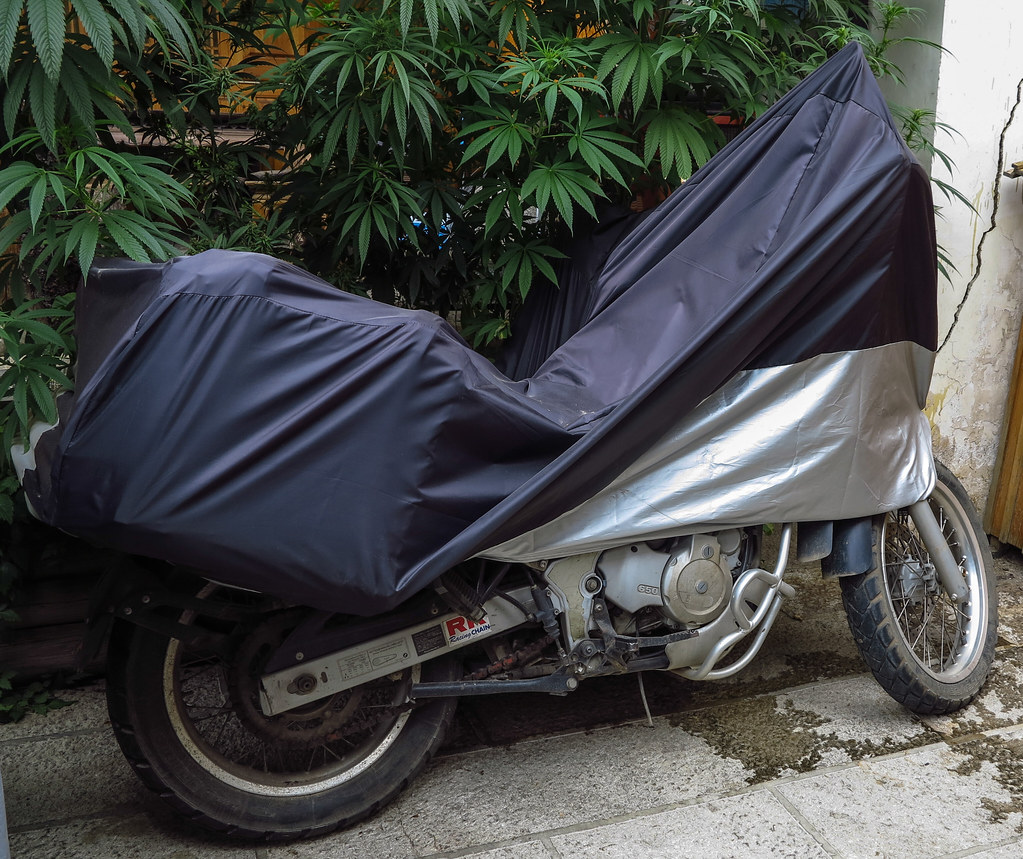

Nice rooms which range from 450 – 800 (suite) Yuan a night


Time to try some yak-milk tea (also known as butter tea).

We’re told the reason this is popular in the region is because it is a great source of protein for the farmers.
Wiki:
Butter tea – Wikipedia, the free encyclopedia
Butter tea[edit]
Drinking butter tea is a regular part of Tibetan life. Before work, a Tibetan will typically down several bowlfuls of this beverage, and it is always served to guests. Nomads are said to often drink up to 40 cups of it a day. Since butter is the main ingredient, butter tea provides plenty of caloric energy and is particularly suited to high altitudes. The butter may also help prevent chapped lips.[1]According to the Tibetan custom, butter tea is drunk in separate sips, and after each sip the host refills the bowl to the brim. Thus, the guest never drains his bowl; rather, it is constantly topped off. If the visitor does not wish to drink, the best thing to do is leave the tea untouched until the time comes to leave and then drain the bowl. In this way etiquette is observed and the host will not be offended.[2]Butter tea is also used for eating tsampa by pouring onto it, or dipping the tsampa into it, and mixing well.The concentrate, produced by repeatedly boiling tea leaves, will keep for several days, and is commonly used in towns. The tea is then combined with salt and butter in a special tea churn (Tibetan: མདོང་མོ་, Wylie: mdong mo), and churned vigorously before serving hot. Now an electric blender is often used.

Here’s our end result. It was pleasant to drink, but all we could taste was butter and salt (you can have a sweet variety too).

The teamaker and his son looked a little apprehensive, worried that we may not have the acquired taste

A stroll around Shangri-La’s town.
The street motorcycle mechanic

Preparing the restaurant food for dinner time

Some very stylish Tibetan boots
Street food


There is a huge percentage of ladies in Shangri-La that still wear traditional Tibetan dress






& some unusual tribal clothing too




A Tibetan monk out for a stroll

Mr. R decides he wants some yak tails for his truck, we’re told the best selection is about 10km out of Shangri-La, so off we go in search of them.
Looks like this Chinese taxi driver has had better days

Quite a selection

The ladies are washing the lower tails and grooming them to get the tangles out so the will be more fluffy . Dried yak meat behind.


Yak intestines



On the way back to town, they’d started trying to get the taxi back on the road, might have been interesting to stay and watch

Back to Shangri-La town & a look around the food market

Not quite sure what this was but there were photo’s of chickens behind so a good guess

The Benelli 600 – 40,000 Yuan / USD$ 6,500 made in China


Card game on the edge of the old town in the afternoon sun


People watching


The key copier

Continuing with our attempts to consume the local delicacies, traditional Tibetan cuisine was ordered in Shangri-La.
Yak stew, brought to the table cold and heated over an alcohol burner
“Momos”
Momo (dumpling) – Wikipedia, the free encyclopedia
Momo is a type of steamed bun with or without fillings. Momo have become a traditional delicacy in Tibet, Nepal, Bhutan, Sikkim, Darjeeling district and Ladakh. They are one of the most popular fast foods in many regions of the Nepal populated with people of Tibetan, Nepali or other Himalayan origins, and in places with a significant Tibetan and Nepalese diaspora, such as Assam, Delhi, Mizoram, Manipur, Nagaland, Meghalaya,Himachal Pradesh, Shillong, Arunachal Pradesh, Uttarakhand, and West Bengal. The same concept appears in Russian cuisine as Pelmeni, which is a Finno-Ugric loan word literally meaning “ear-chaped bread”.
Yak jerky (delicious)
Barley bread, which is eaten with a mix of Yak butter and cheese
Unsweetened barley cake. A dense cake mixture actually rather good as not sweet, not eaten as a desert but part of the main meal.
A very cultural evening, all of us learning about local Tibetan food.
Our last night in Shangri-La, will really miss the place, a really special, ancient town
After dinner, still time left to go watch some of the traditional dancing in the old town square
Superb
Next morning, a very “chilly” start, as we head north towards the Tibet border. Looks like this lanslide gave the driver a nasty headache

You can see the unlucky boulder that hit him to the right of the picture
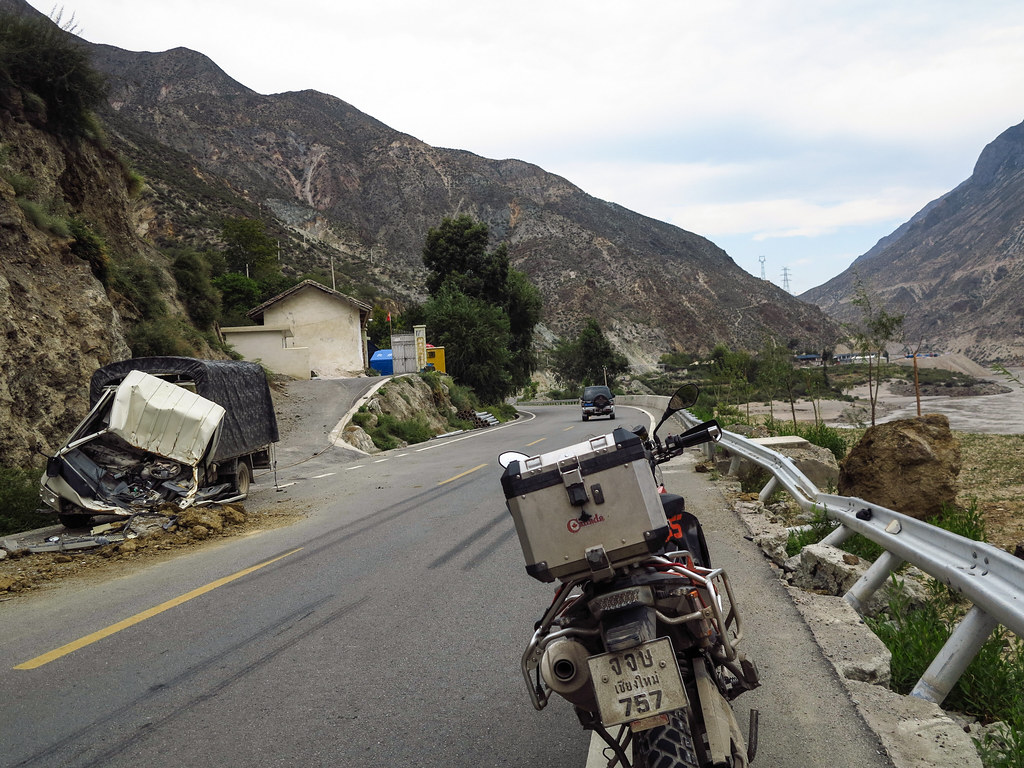

We looked inside the can, no blood anywhere, maybe he survived
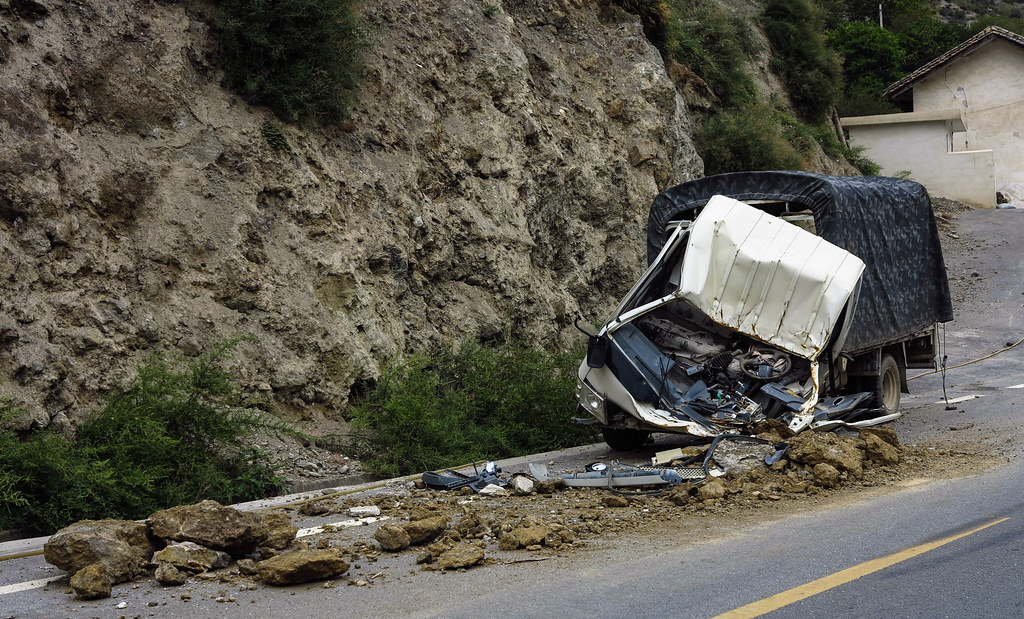
North out of Shangri-La and the ridgeline road has been shut due to an earthquake in the region a few months back. There is an alternative and we hook up with the road that follows the Yangtkze River valley system

Not a road i’d ridden down before, excellent scenery, looks like the road on the western side of the river has just been re-sealed



Headed north and rising, we’re now constantly above 3,500 meters, bloody cold


We talking about how far we could get up the dirt trail on the other side of the Yangtze River


This doesn’t look good, what do we have here?


It turns out they were clearing some potential rock landslides – by hand!

We start the long accent up the White Horse Mountain, the pass to the next valley system (the Mekong River valley system) is 4,298 meters.

It gets bloody cold, Robert saw as low as 7 degrees C

About 4,000 meters and freezing


White Horse Pass, my GPS is actually showing 4,302 meters


White Horse Pass – northern Yunnan, near the Tibet border


Photo session over, 50km to go to Deqin, first views of Kawagarpo mountain

Kawagarbo Mountain – Wiki:
http://en.wikipedia.org/wiki/Kawagarbo
– Never has been successfully climbed to the summit & is now forbidden.
Kawagarbo is one of the most sacred mountains for Tibetan Buddhism as the spiritual home of a warrior god of the same name.[3][5][6] It is visited by 20,000 pilgrims each year from throughout the Tibetan world;[7]many pilgrims circumambulate the peak, an arduous 240 km (150 mi) trek[6] Although it is important throughout Tibetan Buddhism, it is the local Tibetans that are the day-to-day guardians and stewards of Kawagarbo, both the deity and the mountain.[4]
The ancestral religion of the Kawagarpo area, as in much of Tibet, was Bön, a shamanistic tradition based on the concept of a world pervaded by good and evil spirits. Bön encompassed numerous deities and spirits which are still recognized today, and are often connected with specific geographical localities and natural features; the major mountain peaks in the Hengduan Mountains are thus all identified with specific deities. Kawagarbo is one of these. Since its introduction, Tibetan Buddhism has been the dominant religion of the Kawagarbo area, with followers of Gelugpa doctrine being the most common.[4][8]
Tibetans believe the warrior god will leave them if human sets foot on the peak of Kawakarpo, making the ground unholy. Disasters will follow as they lose god’s protection. Tibetans have also established a centuries-old sacred geography around the peak, maintained by religious leaders from local monasteries in negotiation with local villages. This sacred natural site preserves the natural resources and ecological health of the range.[9]
Climbing history
The first attempt on Kawakarpo was made in 1987 by a party from the Joetsu Alpine Club of Japan.
In the winter of 1990–91 a group from the Academic Alpine Club of Kyoto University attempted the peak in conjunction with a Chinese group. Their activity caused heavy protests from the local Tibetan community due to the mountain’s cultural and religious significance. On 3 January 1991, a nighttime avalanche killed all seventeen members of the expedition, in one of the most deadly mountaineering accidents in history. The Kyoto club returned in 1996 to make another unsuccessful attempt.[1][10]
American expeditions, led by Nicholas Clinch, visited the range in 1988, 1989, 1992, and 1993, attempting other major peaks, but were unsuccessful.[1]
In 2001, local government passed laws banning all future climbing attempts on cultural and religious grounds. As of 2010, none of the significant peaks of the range have been successfully climbed.[1]

A couple of km’s north and the city of Deqin appears in the valley below


We’re staying in a more fancy hotel north of Deqin with views of Kawagarbo, so regroup so we don’t lose anyone

Not bad scenery while we’re waiting

Crop drying

After poking around a little, we find the dirt road u the mountain to the hotel


The hotel is amazingly situated with superb views of Kawagarbo Mountain


The mighty CRF 250 L hanging in there



Kawagarbo Mountain


Time to go get checked in, doesn’t look too shabby

Feels like something is up, we find out that there’s a clusterfuck with the booking and they dont have rooms for us

This could be bad or very very good & it turns out it’s very very good. They offer us an upgrade to the spar 400 meters away at no additional cost, we can’t belive our luck, the Chinese give 10c pieces away like they are man-hole covers normally
The upgrade – doesn’t look much from the outside but its gorgeous inside

Pretty sweet

Rooms!

The best bathroom ive seen in years




Morning, moody clouds surround us close to Kawagarbo Mountain, we’re all hoping they will lift as we leave.
Really cold, Robert wrapped up and getting ready for the ride south to Weixi
Quite spectacular to watch the changing patterns in the moisture rising as the sun heats everything up
Time to start heading south away from the Tibet border. This time we’ll be following the Mekong River valley complex & scenic it is for sure, some rider’s said almost as good as Tiger-Leaping-Gorge for photo opportunites
See for yourself
Down through the Deqin valley & we pick up the Mekong River, we havn’t seen it since we left the Tiger-Leaping-Gorge
Oddvar was totally impressed with this route
The Mekong meanders south, with the landscape very baron in places due to continuous erosion
Every 2km in the Mekong River valley, Yunnan, China you have to stop and get your camera out again. Some of the guys gave up putting gloves on as you had to stop so many times and get the camera out
We must have seen 20 suspension bridges connecting to villages on the western side of the Mekong
The last remaining French monastery on the Mekong in Yunnan, China, the rest have been destroyed. They still grow grapes and make wine in the area which had been taught by the French missionaries.
The Tibetan rebellion in 1905
1905 Tibetan Rebellion – Wikipedia, the free encyclopedia
Under pressure from foreigners, the Qing Dynasty government allowed Christian missionaries into Tibetan Buddhist areas in Yunnan province. The Tibetan Lamas had long defied the rule of the Qing authorities and officials, and the Qing dynasty fought against a rebellion of the Lamas around 1905. The Tibetan Buddhist Lamas attacked and murdered Chinese officials, French Roman Catholic Priests from Paris Foreign Missions Society such as Jean-André Soulié or Jules Dubernard, and Christian converts in the area, in retaliation for the missionaries’ success at converting the natives to Catholicism. The Buddhist Gelug (Yellow) Sect was primarily responsible for the revolt and deaths.
Scottish Botanist George Forrest was the primary Western witness to the rebellion, having spent most of it trying to escape from Lamas intent on killing him. He wrote an account of the rebellion which was published in botanical related publications. In 1905, the Lamas started a revolt against the peasant converts from the monasteries. Chinese soldiers were sent to crush the revolt.[1]Forrest wrote that the majority of the people in the Mekong valley in Yunnan were Tibetan. The Tibetan Buddhist Yellow Sect was the dominant power in the region, with their Lamas effectively governing the area. Forrest had a negative view of their reign, since they used “force and fraud” to “terrorise the… peasantry”. The Lamas completely ignored the Imperial Qing authorities in the region.[2]Attacks on Christian Missionaries and Converts[edit]
The British invasion of Lhasa in 1904 had repercussions in the Tibetan Buddhist world. the Tibetan Lamas proceeded to revolt[why?] in 1905, massacring Chinese officials, French missionaries, and Christian Catholic converts.The Lamas besieged Bat’ang, burning down the mission chapel, and killing two foreign missionaries, Père Mussot and Père Soulié. The Chinese Amban‘s Yamen was surrounded, the Chinese General, Wu Yi-chung, was shot dead in the Yamen by the Lama’s forces. The Chinese Amban Feng and Commandant in Chief Li Chia-jui managed to escape by scattered Rupees[clarification needed] (money) behind them, which the Tibetans proceeded to try to pick up. The Ambans reached Commandant Lo’s place, but the 100 Tibetan troops serving under the Amban, armed with modern weaponry, mutinied when news of the revolt reached them. The Tibetan Lamas and their Tibetan followers besieged the Chinese Commandant Lo’s palace along with local Christian converts. In the palace, they killed all Christian converts, both Chinese and Tibetan.[3]George Forrest was residing at the Tzekou French Catholic Mission, which came under attack by the Tibetan Lamas. He fled through miles of mountains to flee the Tibetan Lamas who intended to “brutally” murder him.[4] Along his escape route, he took refuge with Chinese soldiers, but his party was discovered when they past by the Patang Lamasary after the Tibetans heard their presence, the Tibetans blew a “signal whistle” to alert everyone to their presence in the area.[5] Around the Mekong river every Catholic Priest was murdered by the Lamas; they even mounted a Father Dubernard’s head on the Atuntze Monastery’s gate.[6] Forrest was targeted by the Lamas, who pursued him until a Naxi“King”[clarification needed] named Lee rescued him.On July 22, 1905, the Tibetan Lamas killed the French Catholic missionaries[7] Père Pierre-Marie Bourdonnec and Père Jules Dubernard[8] around the Mekong.[9] A Chinese military mandarin informed Forrest on how exactly the Tibetans killed his friends. The Tibetans “disembowelled, beheaded and quartered” the body of Pere Bourdonné after he was shot to death. Chinese soldiers guarded Forrest from the Tibetans pursuing him.[10]Jules Dubernard had been tortured for days by the Lamas.[according to whom?] His upper limbs were both fractured and restrained, he was secured on a stake, his eyes were gouged, his tongue, ears and nose severed, while he was living, his extremities were severed. The body parts of the French priests were sent by the Tibetans to be displayed at Lamaseries. Forrest lost a great deal of his scientific data, photographs and specimens of plants he was collecting.[11]At the Atuntze Monastery the Tibetans mounted the decapitated heads of the French priests.[12]
A bit apprehensive about the road situation south of the monastery, the road is often closed & the earthquake that happened on August 31st, 2013 (A 5.9-magnitude quake has hit southwest China near border of Yunnan and Sichuan, U.S. Geological Survey reports.) won’t help our odds.
Lady luck on our side, everything had been cleared and we could head south on the broken, rubble road.
Cliff-like walls in the Mekong valley
Looks like a tunnel is being made westwards linking to the Salaween river valley complex in Yunnan, from the Mekong River valley.
Tunnels are one of the most dangerous and off-putting things we encounter riding in China. Most of them are unlit and immediately curve when you enter them
A very unusual double suspension bridge across the Mekong’
Some of the first “terraced” rice fields we’ve seen, they’ll be plenty more in a few days as we head SE
Rice fields on the banks of the Mekong River
On the way home from the gardens, looks like hard work
Which way??
Gaoquan village, north of Weixi
Back down in the tropics, 25 deg. C warmer than this morning and into the hotel in Weixi, a great day
Leaving Weixi, looks like another great days riding ahead of us
South along the Yangtze River and a quick stop at a temple we havn’t investigated before
A decent lunch-stop 80km north of Shaxi
Robert & John making friends with the locals
Great kitchen!
Grandma at the Yak butter tea stop keeping and eye on everything
Back to the lower altitude regions with water and its rice harvest time
Further south towards Shaxi and the crop hasn’t been cut yet
This farmhouse was actually newly constructed in traditional style
We’re now back in the Yangtze River valley which will take us south to the historic tea horse trail town of Shaxi
A long day, just under 8 hours of moving time and we arrive that the best located hotel in the heart of Shaxi (Sha-shi)
The Chinese were taking more photographs of the bikes than they were of the 600 year old surrounding buildings
The view of the old theater opposite our hotel, stupendous
A typical farmhouse in the Yangtze River valley, most homes had corn, barley and rice drying
It was the first time we’d stayed in this hotel id Shaxi, we found it last time we were here and knew at first it was the best spot in town
Oddvar’s room with it’s authentic 600 year old walls
Shaxi at dusk
Time for the first one of these
This Taiwanese owned hotel is superb in every way, total class. Even the food was outstanding.
Everyone liked the style of this hotel
A late start, so time for a few photo’s around the only remaining authentic Tea Horse Trail town. We’ve been told it survived the cultural revolution because it was hidden in the valley.
From Wikipedia, the free encyclopedia
Jump to: navigation, search
Shaxi (Chinese: 沙溪) is a historic market town in Jianchuan County, Dali Prefecture, Yunnan province, China. It is located roughly halfway between Dali and Lijiang.
The Sideng market square of Shaxi was added to the World Monuments Watch List of 100 Most Endangered Sites in 2001.[1]
Shaxi started as a trading point for tea and horses during the Tang Dynasty (618 – 907). The prosperity of the town was at its height during the Ming and Qing dynasties (1368–1912).
It is probably the most intact horse caravan town on the Ancient tea route leading from Yunnan into Burma and Tibet[2] and is now being preserved through a cooperation between the Swiss Federal Institute of Technology Zürich (ETH) and the People’s Government of Jianchuan County.[3]
Nearby Shibao mountain contains Buddhist rock carvings and temples of over 1300 years old with, amongst others, images of the bodhisattva Guanyin.
The two main ethnic groups of Shaxi are the Bai and Yi people.More info and photo’s regarding Shaxi in the links below:
http://www.rideasia.net/motorcycle-f…html#post16320
& here:
http://www.rideasia.net/motorcycle-f…html#post29869
& some good restoration info in the link below:
This ancient Tea Horse Trail town is a photographers delight, you’ll never see anything like this anywhere that’s authentic
As on many entrances, pictures famous ancient warriors guard the premises
Getting ready to leave & the bikes were getting more attention than the ancient surroundings
Mr. R making new friends
As we were leaving with all our robocop gear on it really got their interest
Drizzle and a little chilly, we make our way towards Shuanglang. This must have ruined this chaps day.
Into a drizzly Shuanglang, the rain just stops as we arrive of course
Hotel has good secure parking and right in town on the eastern side of the lake
Erhai Lake to the west of Shuanglang, with the mountain backdrop is a more interesting stop than Dali old town most people were saying. We managed have a look around before it got dark.
Wiki:
Erhai Lake – Wikipedia, the free encyclopedia
Erhai is situated at 1,972 metres (6,470 ft) above sea level. In size, the North-South length of the lake is 40 kilometres (25 mi) and the East-West width is roughly 7–8 kilometres (4.3–5.0 mi). Its area is 250 square kilometres (97 sq mi), making it the second largest highland lake of China, after Dianchi Lake. Its circumference reaches 116 kilometres (72 mi), its average depth is of 11 metres (36 ft) and the total storage capacity of 2.5 billion cubic metres (2,000,000 acre·ft).
The lake is sandwiched between the Cangshan Mountains to the West and Dali City. It starts at Dengchuan at its northern extremity and finishes at Xiaguan city in the South, receiving water from the Miju and MiciRivers (in the North), the Bolou River (in the East) and smallers streams from the Cangshan Mountains. Yangbi River is the lake’s outlet in the South and eventually flows into the Lancang River (Mekong River)
Dusk, the last of the sunset poking through the clouds
A few more shots of the lake before dark
The hotel on the island in the lake
Shuanlang noodle shops

A superb photo from Axel using his Nikon D800 illustrating the ancient art of bottle opening the Chinese way
South out of Shuanlang, passing down the eastern side of Erhai Lake, even on a dull day, it’s spectaular

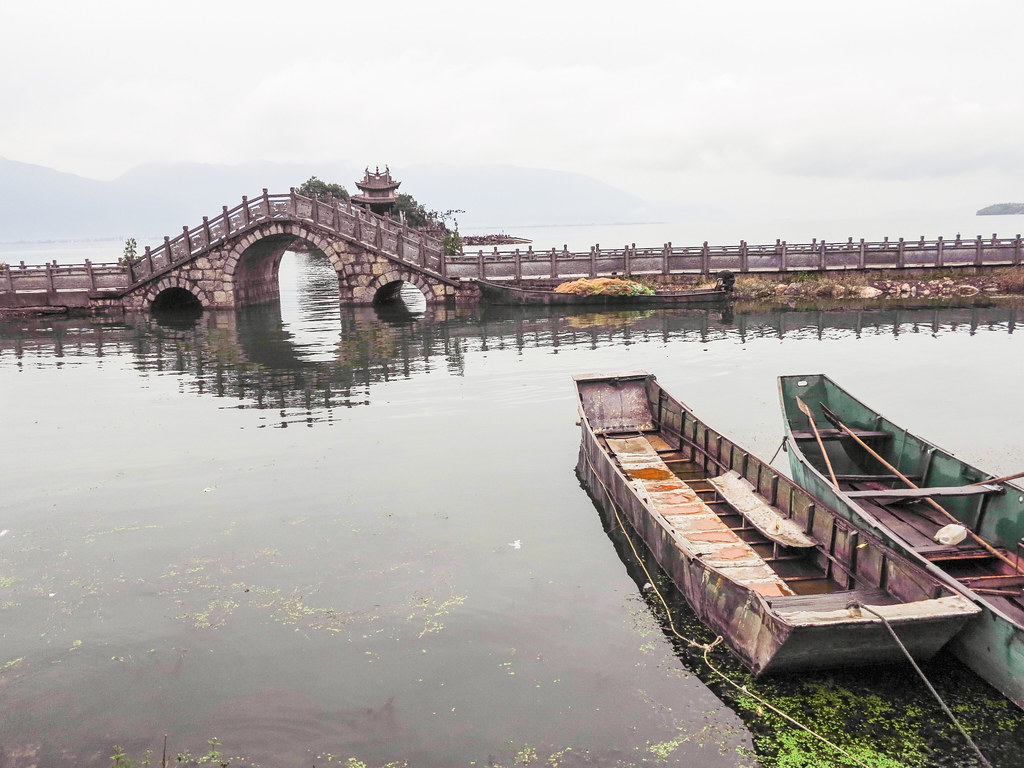
We met this adventure rider from Kunming that had ridden this 150cc bike up into Tibet!

Nasty traffic jams getting into Kunming city, tonight going fancy, The Grand Park Kunming Hotel, USD$ 110 a night
Wherever you park motorcycles in fancy hotels in China, the will ALWAYS ask you to move them, even if it’s the most logical spot

Gorgeous rooms, this will be a good night sleep for sure, huge rooms


Interesting view over Kunming too

In the last 6 months in China, they’ve released a 400cc adventure bike.What makes it interesting is that the engine is a copy of the air cooled Honda XR 400 engine, which has a great reputation for reliability and simplicity.
Bring on the Shineray GX 400 Motor. 30,000 Yuan road registered/ USD$ 5,000 makes it worth a look with the copy XR 400 engine

We managed to persuade them to bring it out of the showroom so we could test it, Mr. R giving it a close inspection
They rigged up a fuel bottle for a test ride

Suspension felt ok for a cheap bike



I took it for a spin and was surprised how much power there was, it was night and day different from a 250, very heavy though, we were told around 170kg

The gear selector shaft protruded out of the engine casing and looked a huge weak spot if hit on some rocks in a fall

The XR 400 copy engine

Once we’d got it out of th showroom, the locals were keen to give it a go too

Leaving Kunming, we approached this Chinese policeman who’s excitement overwhelmed him
Lot’s of radio-ing and other Chinese officers turning up, after carefully examining our temporary Chinese registrations and driving licenses, after about 15 minutes we were free to go.
A beautiful old temple on the way south
Roast duck lunch north of Juan Shui
This is a busy restaurant, this is how they start out
Duck intestines drying in the sun
The end result
35km to go to Juan Shui, harvest time, rice cut and thrashed into a huge metal container
A 9 day fair associated with Confucius near Juan Shui, here grinding sesame seeds into a paste
Looks like they’re planning on selling a lot of sausages
Into the Linan Hotel, Juan Shui, one of the fanciest we’ve stayed in
Huge, beautiful rooms
Highly recommended
Rest day in Jian Shui, so off to the Tuan Shan ancient village on the bikes
From : Yunnan Tuanshan Village – China culture
In Tuanshan Village, there are residential complexes built 600 years ago which have well reserved the characteristics and social and humanistic environment of the Southern Yunnan villages in the 19th century and 26 best preserved traditional folk houses and ancient buildings of the late Qing Dynasty, for which the village is reputed as “Loulan Ancient City in Yunnan”.The extant old architectures consist of traditional Han Chinese courtyard built of grey bricks, tuzhangfang (earth-rammed house) of Yi ethnic group and the tuzhangfang with tile eaves of combined Han and Yi style. The building complex includes those courtyard houses of one hall, two halls and three halls as well as those of crisscross yards, covering the traditional residential forms of “four-side courtyard house with five raise headings”, “three-side courtyard house with a screen wall facing the gate” and “horse running building” (Square courtyard with two-layer buildings on four sides in which the corridors are connecting with each other so that “the horse can run on the corridor”) in Yunnan. All the houses stand facing east and exposed to the sun. Walking down the old flagstone paved road of the village, you would be aware of the 19th-century farming culture in southern Yunan Province as well as the supplemented humanistic culture which are reflected in various aspects from the architecture, sculpture, painting to calligraphy, couplets, poems and local customs.
This was a military General’s home. Above the entrance to his home, the center gold insignia is of an ancient Chinese weapon
Beautiful old buildings in the Tuan Shan village
More paintings of ancient warriors protecting the homes on doors
Tuan Shan village
Photo’s and memorabilia litter the town of the Chairman Mao era
Beautiful paintings are everywhere
Into the beautifully restored Zhang family residence in Tuan Shan
Its a typical Han tribal courtyard arrangement
If you pass through Jian Shui, don’t miss Tuan Shan
A old shop in Tuan Shan, will slogans supporting Charmian Mao still plastered across it’s storefront
5km from Jian Shui, you also have the spectacular Twin Dragon Bridge
From: Twin Dragons Bridge, China Jianshui travel guide, Kunming tour Yunnan to Jianshui Shuanglong Bridge
Five kilometers west of Jianshui , at the confluence of Lujiang River are the Tachong River, lies Shuanglong Bridge. A combination of science and art, the stone bridge ranks first in Yunnan Province in terms of size and artistic value. It is now under provincial protection. When the bridge was built during the reign of Emperor Qianlong in the Qing Dynasty, it had only three arches on the north end. Later on, as the Tachong River changed its course, fourteen new bridge arches were added to the original ones and thus got the name “the Seventeen – Arch Bridge”. It is a masterpiece among ancient bridges in China.
Beautiful, bright blue skies leaving Jian Shui, perfect day for a ride.

Bamboo cutters busy in the early morning

Further south, we sat and watched these 2 trucks scrape against each other, then the argument about who’s fault it was

A little hazy, but the valley was impressing most riders


Off to the fields – The lighter coloured tribal is are the “Wi”, dark colored tribal dress tends to be “Hani” tribe

Here, approaching the Hong He rice terraces, one of the large villages on the outskirts

First time I’d seen the terraces just after a rice harvest, completely different colors

The Hong He rice terraces can be traces back 1,200 years, we were told they only get one rice crop a year here





Harvest nearly completed

Noodle soup in a small village , all the small boys are amazed by the big bikes


A Wi tribal lady in traditional costume poses for us


Oddvar in the mirror getting all of the rice terraces on the GoPro

All of the manual labor at the construction sites in the Hong He valley were worked by females

Wi construction workers


Nice, twisty roads ahead in the rice terrace valley


Further inside the valley, we came across a bunch of locals practicing some traditional carpentry


The more elderly gentlemen were supervising & having a smoke

Not sure what this guy was smoking but it looked like he’d had a skinfull

We eventually found out that they were making a coffin and the tradition was that close family and friends of the desist, all came together and made the coffn by hand






An interesting home-made contraption



A couple of rice terrace snaps from the big camera



Lunch in the Hong He terraces, there’s only one kind of noodle soup for lunch in China and this is it


Another WI tribal lady with her grandchild

Then down to the Red River Valley


Blue skies all day, 330km of great riding, everyone happy as we pull into Yuan Jiang


A highway blast southwestwards to the Xishuangbanna (Sipsongpanna) region, lots of history and events here from the early 1900’s (& back to the 1200’s)

From Wiki:
Xishuangbanna Dai Autonomous Prefecture – Wikipedia, the free encyclopedia
In the chaos of the Xinhai Revolution that overthrew the Qing government in 1911 in favor of a Chinese republican government, a local official, Chao Meeng Jie, staged a rebellion against the Qing remnant officials. TheYunnan provincial government of the newly-established Republic of China sent troops in 1913 to oust the rebels.[6]:137-138 Ke Shuxun remained in Xishuangbanna to govern with his “13 Principles of Governing the Frontier”, which emphasized ethnic, taxation, and land ownership equality between Han and Dai; allowance of intermarriage between the ethnic groups; and education in secular and technical subjects relevant to China, rather than Burmese-based monastic education.[6]:156-158 The Second Sino-Japanese War (1931-1945) saw the heavy bombardment of Xishuangbanna by Japanese troops and a simultaneous influx of Pan-Taiist propaganda from Japan’s ally, fascist Thailand.[citation needed] This temporal combination reduced the appeal of a broad pan-Tai identity among the Dai Lue.[6]:173-174
During the final phase of the Chinese Civil War, many remnants of the Guomindang fled the victorious Communists into Burma’s Shan State from Xishuangbanna. The new People’s Republic of China sent various non-military expeditions to Xishuangbanna from 1949, including the “Central Visiting Group for the Minzu” (中央民族访问团, Zhōngyāng mínzú fǎngwèn tuán) to provide services such as schools and hospitals to replace those from Christian western missionaries that had the ulterior motive of converting the Chinese ethnic minorities.[6]:193-194 The Communists liberated the prefecture from Guomindang loyalists in 1952. On January 23, 1953, the People’s Republic of China (PRC) established the Xishuangbanna Dai Autonomous Region and ended the native-chieftain system. That year, the People’s Congress of Xishuangbanna created the New Dai Lue alphabet in order to provide for convenient printing of the Tai Lü language.[6]:243-244
Xishuangbanna was renamed an autonomous prefecture in 1955, but lost some territory as the Hani and Yi-inhabited areas of Jingdong and Jiangcheng became their own autonomous counties.[6]:40 Peacefully negotiated land reform (和平协商土改, hépíng xiéshāng tǔgǎi) started in earnest in January 1956, finally destroying the power of the village headmen.[6]:188-189, 211 State-owned rubber plantations accounted for most of the region’s wealth during the early PRC period. Xishuangbanna also received a wave of educated youths during the late 1960s Down to the Countryside Movement. During the Cultural Revolution (1966-1976), Buddhist temples in Xishuangbanna were used as barns, although they have been retored to their original purpose in 1981.[6]:239 In 1987, the Xishuangbanna government promulgated the Law of the Xishuangbanna Dai Nationality Autonomous Prefecture for Self-government in order to harmonize local laws with the national Law of the People’s Republic of China for Regional National Autonomy.[6]:68 Shao Cunxin (召存信, 1922-), former head of the Chieftain’s outer council (1944-1950) and chief of Meng Peng (1938-1950), was the chief of the autonomous prefecture from 1955 to 1992.
We’d planned to end the day in Jing Hong, a city that the Mekong River passes through
Into the city

Into the fancy Jing land hotel, Jing Hong


Jing Hong has some interesting ties with Chiang Mai, Thailand:
In 1296, Lanna’s capital Chiang Mai was founded by Mangrai, whose maternal grandfather was King Rung Kaen Chai (Thai: รุ้งแก่นชาย) of Jinghong (i.e.: Sipsongpanna).
(Jinghong – Wikipedia, the free encyclopedia)
Jing Hong is now a huge city with a population of around 450,000, with palm tree cladden shopping streets, not a small dusty town as you’d expect close to the Myanmar border.

Being so close to Myanmar, even the road signs are duplicated in Myanmar text

Down to the Mekong River in Jing Hong and a look at the new bridge


You can take a ferry from Jing Hong, China to Chiang Saen, Thailand. the ferry was stopped for a while after the murders of the Chinese sailors, but we’re told is now running again
From:
mekong Cafe-information boat from Jinghong Xisuangbanna China to Thailand
There is a fast and confortable boat going from jinghong to chiangsaen in Thailand; the trip on the Mekong river is worth the price ..around 700 RMB and takes about 9 hours to get to destination, The China exit formalities are done at the Jinghong harbour immigration point, there is no need for a Burma or Laos visa, There are no stops in Burma or Laos, the Thai visa is issued at Chiangsaen immigration office upon arrival for a period of 15 days
Maekhong Delta Travel Agency
230/5-6 Phaholyothin Rd., Wieng Pang Kham, Mae Sai, Chiang Rai 57130 Thailand
phone. ![]() +66 053 642 517 Fax. (66) 053 642 520
+66 053 642 517 Fax. (66) 053 642 520
[email protected],

The Mekong River waterfront in Jing Hong is a bustling hive of activity


Restaurants with a boat like theme

& some in a more tasteful Lanna style

Sadly, most of the street food vendors in China have been chased from the streets by the police, they are constantly looking around and ready to move on

Everyone has their wheels at the ready



Continuing with the theme of trying to eat local ethnic delicacies, now in the Sipsongpanna region of China, time for some authentic Tai food.

Apparently, there was a party being held in the same restaurant to celibate a child’s 100th day from being born


So here comes the Tai ethnic food and what a box of chocolates it was
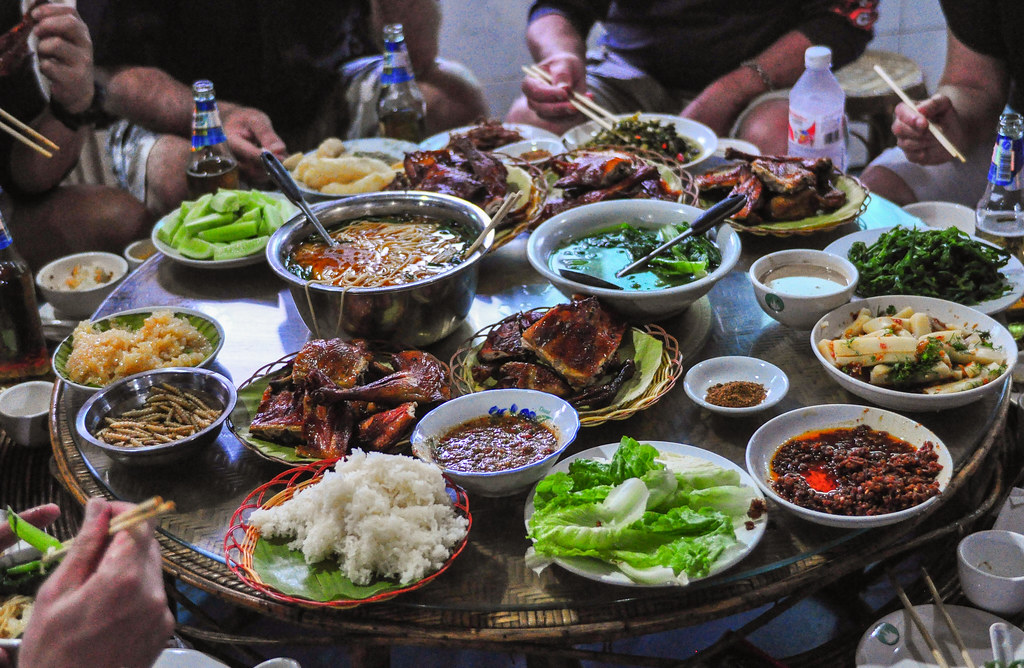
Buffalo jerky that had been shredded

The skin from processing bean curd (soy)

Pineapple mixed with sticky rice – This was the first time on the trip we’ve come across sticky rice, which need a warmer, low altitude environment to grow

A noodle soup with some ground meat

Some kind of worms/ bugs fried

An omelet type of cake filled with green leaf vegetables
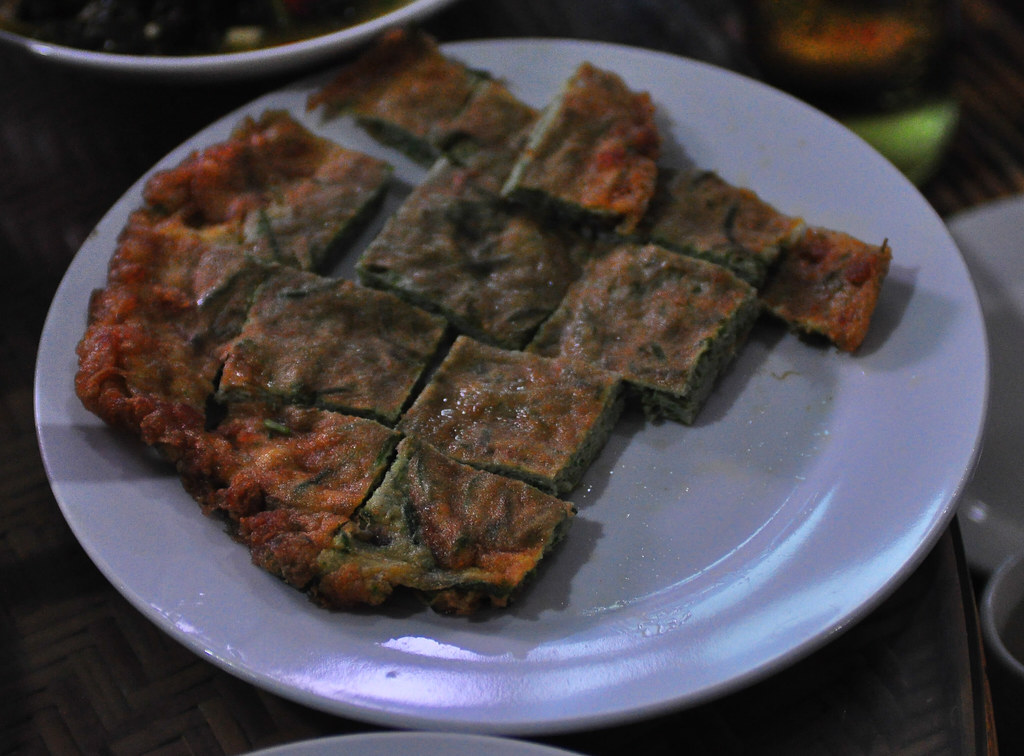
Minced pork, almost like a Thai dish but not spicy

& regular sticky rice

After dinner, being our last evening in China (Laos the next day), time for some gift giving to remind us of the China experience.
John – A night club owner from Canada, ride’s a BMW 1200gs back home, almost like riding with your very-own stand up comedian, never a dull moment, that’s unless you’re waiting for him to get ready in the morning. The 8am starts were sometimes 8.15am starts, so a wrist watch for him.

Robert from Malaysia, has a multitude of motorcycles, this trip on a BMW 1200gs Adventure. One of the gentlest, nicest guys you’ll ever meet, a successful civil engineer & recently retired. Maybe something needed to fill all that free time he has now – A Chairman Mao needlepoint, we want it finished on while waiting for the Houy Xai / Chiang Khong ferry.

David from New Zealand, a money manager/ financial adviser , who’s an avid dirt bike rider back home with a multitude of dirt bikes and runs a motorcycle touring business in South America. He’s up at 0450am every morning then off to gym – for him a cloth hat to catch all the sweat.

Susan (who’s married to David), mother of 3, who juggles that with managing their farm in NZ, didn’t complain once about the nasty toilets on the whole China ride, for her, what every lady needs, more shoes (these were from Shangri-La.)

Thomas from Germany, the Donald Trump of Ko Samui. Lives in Thailand with 3 daughters & has several motorcycles. The most opinionated rider on the trip & was often right, went ahead approaching Kunming city and we lost him – “marching to a different drummer”, this was quite appropriate and very funny.

Axel from Austria, he has more fingers in more pies than anyone I know. Restaurants, import/ export, retail shops, commercial pilot, it goes on. He has a multidude of bikes ranging from 250 MX bikes to a Harley, this trip on his BMW 1200gs. He also owns several homes, so how about a wall painting from Yunnan.

Oddvar is from Norway, lives in Thailand and is a Captain aboard super tankers. In 4,000km, I didn’t hear him mutter one negative comment, one of the most positive people i’ve ever met, a breath of fresh air. He has a Valkyrie (naked Goldwing) , this trip, like myself on a Honda CRF 250 L which he loves. What do you get the guy that has everything? How about a Yunnan inner ear scaper.

And last but not least our Chinese driving licenses and Chinese motorcycle registration, unfortunately only valid for the 30 days of our Chinese immigration visa’s




Out for dinner and spotted this. We all kind of agreed that it would qualify for “hands free” telephony


Back in Laos
In Jing Hong, China, we did a rough calculation & knowing our average speeds for various road conditions for the last 4,000km, it looked like we might be able to make Chiang Khong, thailand in one day including 3 different countries of immigration and customs clearances. The stars would have to be aligned, but it looked possible.
So early start for everyone, not even light

Underway and time for one of the last leaks in China

Early morning, really cold around the Mengla region

Into the Mohan, China border area and money changers appear like a pride of lions feeding on a zebra

Time-wise, all looking pretty good. Here at the Mohan checkpoint, waiting for a Chinese outbound clearance


All going really well and real speedy, through inbound Laos immigration in a flash and 3 km south to Laos customs

While passing through Boten, Laos, just south of the Chinese border, interesting to see the duty free shopping complex starting to take shape

Axel’s Touratech headlight adjuster, he couldn’t see anything in the tunnels


The chicken feet from dinner, taken as a memento on John’s BMW F 800

We made amazing time into Chiang Khong 3.45 pm…. managed to get the last ferrt to wait for our customs clearance out of Laos

We didn’t have our passports stamped out of Laos, the ferry was about to leave Laos agent said go across and i’ll bring the passports over to Chiang Khong

So we did it China to Thailand in a daylight on motorcycles including border crossing, quite a day. Looking at it now, on a big bike, Chiang Mai to Jing Hong, China might be possible in a day.
You can see more of our China motorcycle photos by clicking here
A China motorcycle tour around the Yunnan province is one hell of a ride, in fact it might be the best Asian motorcycle tour i’ve ever done.
If you are interested in one of our motorcycle tours into China, then click on the link below:
Click here for information on joining a motorcycle tour to China



